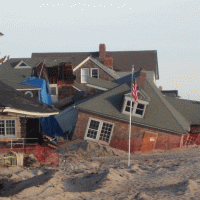In recent years, with Hurricane Ike in Galveston, TX in 2008 and Superstorm Sandy along the New Jersey and New York coastline in 2012, we have had the opportunity to see firsthand the destructive power of storms like these. We were “boots on the ground” literally days after the initial coastal strike. The damage observed to residential and commercial structures was far reaching, diverse and some preventable. We want to share some “lessons learned” from these observations for these two CAT events.
First of all, no two storms are alike. Some storms are massive in size, slow moving and have heavy rainfall causing tremendous storm surge issues while other storms may be compact, fast moving and are more of a wind event with accompanying rains. The damaged structures had been built over a wide range of time periods and under many different building codes. The older the structure, the less likely it meets current wind, flood and hurricane design requirements.
Many structures that are damaged by these storms sit in prominent exposure areas such as beach oriented properties. While there has been a heavy migration of Americans to our shorelines, whether it is in New Jersey, the Carolinas, Florida or the Gulf coast, the structures that house or service this population have not kept up with the demand for hurricane resilient construction. A common trend is for older houses and commercial buildings to be renovated and upgraded with maximum cosmetic upgrades, (kitchens, bathrooms, flooring, etc.) yet performing minimal structural upgrades in compliance with newer codes. This false sense of “new” overshadows the fact that the structure may still be vulnerable to minor or even major damage during Category 2 or 3 hurricanes.
In the recent storms of Hurricane Ike and Superstorm Sandy a phenomenon occurred which dealt with storm surge. In years past, such CAT events as Hurricane Andrew, Wilma and Charlie in Florida were “traditional” hurricanes where the majority of the damage which occurred came from high winds. However with some of the recent storms we are now dealing with, it is now the storm surge that has become the source of major damage.
Many CAT claims focus on “wind vs water” cause and origin determination. Hurricane Ike in 2008 was really the first hurricane that had significant, on the ground, weather data collected which was used to scientifically establish the timing of the rising water from the storm surge vs the timing of the wind gusts. In this storm, the rising water of the storm surge was literally hours ahead of the hurricane force winds recorded.
With this data in hand and the known forces that wave action has on a structure, the cause and origin of many structures were able to be accurately and scientifically supported that rising water from the storm surge caused the damage to the structure first before the hurricane force winds were even present. Many structures that were observed that remained standing had the typical damage characteristics of storm surge damage including scour of the foundations, damage to only the lower portions of the buildings, high water marks in and around the structure and roof shingles intact and undamaged.
In future CAT events, we may have the same trend of storm surge damage far outweighing wind damage or it could be just the opposite. Having qualified engineering experts inspecting these structures and providing the scientific data to support the timing of damage will quickly and accurately determine the cause and origin of damage to a structure.
Founded in 1997, The Warren Group, forensic engineers and consultants provides technical investigations and analysis of personal injury and property claims as well as expert testimony for insurance adjusters and attorneys. Extremely well versed in the disciplines of mechanical, electrical, chemical, structural, accident reconstruction and fire and explosion investigation, our engineers and consultants are known for delivering the truth — origin, cause, responsibility and cost of an event or claim — with unmistakable clarity.






